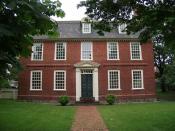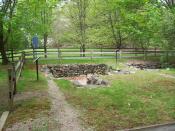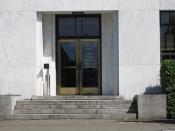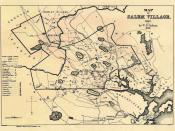The Devil in Massachusetts is the story explaining what occurred in Salem Village in 1692. Salem Village was a little Puritan community where, as in all early colonial towns and villages during the time, religion was social life. The Puritan religion was formed by the differences in beliefs from the Church of England. Many searched for becoming free from religious persecution and found a sanctuary in the new world. The Puritan religion was inflamed in everyone and faith was strong, but once talk of witchcraft broke out in Salem Village, terror and paranoia overcame the community. From the spring to summer of 1692, 72 years after Plymouth was first founded in 1620, a mass hysteria swept over Salem Village when the word "witch"ÃÂ was mentioned. Although some of the accused did seem a little mentally disable, some saw the trials as a way to gain power and accused some towns people for their own personal gain.
Childish fantasies of little girls in Salem Village provoked the witch hunts. The girls became possessed and paranoid of trouble, and accused many of possessing and cursing them. Betty Parris was nine years old and Abigail Williams was eleven, both cousins, who were two of the most known about girls from the trials. During court, all the girls would cry out and scream anytime the word God was mentioned or the accused looked towards the, Betty was always the sweet and innocent of the two, but Abigail was a hidden hellion just waiting to break out if she had the chance. Both girls lived in the house of Reverend Samuel Parris, the newest minister to the Salem Village church.
Tituba is the Parris's slave from Barbados. She mostly takes care and looks after the girls, for Mrs. Parris is always running around town helping where she can. Tituba was also the girls' playmates teaching them many lessons from Barbados. Girls from all around the town gathered in the evil that was occurring in the Parris household.
Once "witches"ÃÂ were pointed out throughout the town, and blame was being placed on numerous persons, Magistrate Hathorne was sent out of Salem Town from the General Courts to conduct the trials. He oversaw all of the court proceedings and accompanied by others, examined listened to all the testimonies of the accused. Magistrate Hathorne was the one who made the final decision of who the "witches"ÃÂ really were.
Reverend George Burroughs was called the "tall man from Boston"ÃÂ. The girls kept saying that the one who possessed them was a tall man from Boston, although no one knew whom they were referring to. George Burroughs was the reverend in Salem Village two people before Reverend Parris became reverend. Burroughs was accused of being the "ringleader"ÃÂ of the witchcraft.
Although the witch trials only lasted a few months, twenty "witches"ÃÂ were executed, maybe not a huge number, but the hysteria affected everyone somehow in Salem Village and surrounding areas. Many people were accused strictly because someone else was jealous of them or scared or wanted more power in the village.
The Devil in Massachusetts is recommended by the reader as an informative book into what really went on during 1692 in Salem. Hysteria and fear overtook the village and its interested to see how a town or village during the colonial times would react to something of this extent. Historians don't usually include much about witch trials in history courses, and by reading this book you get a great insight into Salem witchcraft. This book can probably only be understood by someone in higher levels of education in high school and by a reader in college.





